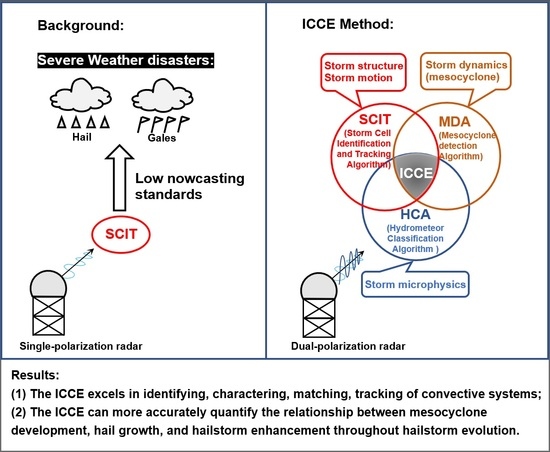Integrated Convective Characteristic Extraction Algorithm for Dual Polarization Radar: Description and Application to a Convective System
Abstract
1. Introduction
2. Materials and Methods
2.1. Observations
2.2. Data Pre-Processing
2.2.1. Pre-Processing Requirements of the Original SCIT and the Modified SCIT
2.2.2. The Pre-Processing Requirements of NSSL-MDA
2.3. The Modified SCIT Algorithm
2.3.1. Identification Methodology for Convective Systems
- Determination of the reflectivity thresholds
- Identification of the 3D convective systems and valid point projection method
2.3.2. Production of Microphysical Characteristics of Convective Systems
2.3.3. Tracking and Forecasting Methodology for Convective Systems
2.4. The Original SCIT Algorithm and Cell Matching Method
2.5. Production of Mesocyclone Characteristics and Mesocyclone Matching Method
2.6. ICCE and Convective Characteristic Parameters
3. Results
3.1. Algorithm Performance Evaluation
3.1.1. Identification and Matching Results
3.1.2. Tracking Results
3.2. Advantages of ICCE Products in Observing Hailstorm Evolution
4. Discussion
- (1)
- The determination of the identification thresholds used in the modified SCIT algorithm. The threshold, chosen in this paper to be 30 and 35 dBZ, was obtained statistically from the reflectivity of hail and graupel output by the HC algorithm. As the HC algorithm is based on a statistical fuzzy logic approach, it does not directly observe the hydrometeors within the convective system and, therefore, still differs from reality. The involvement of other dual-polarization radar parameters (e.g., ZDR, KDP, and ρhv), in addition to the already existing reflectivity (i.e., Z), may still be required in future recognition identification thresholds.
- (2)
- The optimization of the convective system tracking algorithm. The tracking algorithm of convective systems used in the modified SCIT algorithm in this paper still adopts the centroid tracking algorithm used in the original SCIT algorithm proposed by Johnson et al. [2], which may lead to tracking interruptions with the splitting and merging of some large convective systems, and a better tracking method may be established in the future by referring to the tracking advantages of the Tracking Radar Echoes by Correlation algorithm [2] for large-scale echoes.
5. Conclusions
- (1)
- The modified SCIT: Based on the original SCIT algorithm using mosaic reflectivity data, we propose a modified SCIT algorithm, which is better able to identify and track convective systems and their hail and graupel after selecting reflectivity thresholds determined based on reflectivity factor with hail and graupel statistics, establishing a 3D convective system with a complete structure of the main body based on the valid point projection method. Furthermore, we introduce the HC data to increase the characteristic parameters of the area and height of hail and graupel and track the convective system using the centroid tracking method of the original SCIT algorithm.
- (2)
- The original SCIT and cell matching: Based on the original SCIT algorithm using mosaic reflectivity data, we add hail characteristics to the original SCIT algorithm, which can allow for distinguishing between hail and non-hail cells by introducing HC data and obtaining the height range of the hail distribution of the hail cell, in addition to its structural characteristics. To study the local variability of characteristics within convective systems (especially large line storms and cluster storms), a cell-matching method is also used in this paper in order to localize storm cells.
- (3)
- NSSL-MDA and mesocyclone matching. Based on the NSSL-MDA algorithm proposed by Stumpf et al. (1998) [9], we lowered some of the parameter thresholds of the algorithm to obtain more mesocyclones and larger updraft velocity, and a mesocyclone matching method was also applied to mesocyclone localization in order to obtain the dynamical characteristics of the convective system.
Author Contributions
Funding
Data Availability Statement
Conflicts of Interest
Appendix A
- (1)
- COMPONENT AREA 1–2
- (2)
- DEPTH DELETE
- (3)
- DROPOUT COUNT
- (4)
- DROPOUT REF DIFF
- (5)
- NUMBER OF SEGMENTS
- (6)
- REFLECTIVITY 1–2
- (7)
- REFLECTIVITY LENGTH 1–2
- (8)
- SEGMENT SEPARATION
- (9)
- SEGMENT OVERLAP
Appendix B
- (1)
- SPOL
- (2)
- HC
- (3)
- The original SCIT
- (4)
- The modified SCIT
- (5)
- NSSL-MDA
- (6)
- VIL
- (7)
- GR
- (8)
- RH
- (9)
- Convective system
References
- Kumjian, M.R.; Ryzhkov, A.V. Polarimetric signatures in supercell thunderstorms. J. Appl. Meteorol. Clim. 2008, 47, 1940–1961. [Google Scholar] [CrossRef]
- Johnson, J.T.; Mackeen, P.L.; Witt, A.; Mitchell, E.D.W.; Stumpf, G.J.; Eilts, M.D.; Thomas, K.W. The storm cell identification and tracking algorithm: An enhanced WSR-88D algorithm. Weather Forecast. 1998, 13, 263–276. [Google Scholar] [CrossRef]
- Han, L.; Fu, S.; Zhao, L.; Zheng, Y.; Wang, H.; Lin, Y. 3D Convective storm identification, tracking, and forecasting—An enhanced TITAN algorithm. J. Atmos. Ocean. Technol. 2010, 26, 719–732. [Google Scholar] [CrossRef]
- Wang, P.; Shi, J.; Hou, J.; Hu, Y. The identification of hail storms in the early stage using time series analysis. J. Geophys. Res. Atmos. 2018, 123, 929–947. [Google Scholar] [CrossRef]
- Joe, P.; Burgess, D.; Potts, R.; Keenan, T.; Stumpf, G.; Treloar, A. The S2K severe weather detection algorithms and their performance. Weather Forecast. 2004, 19, 43–63. [Google Scholar] [CrossRef]
- Witt, A.; Eilts, M.D.; Stumpf, G.J.; Johnson, J.T.; Mitchell, E.D.W.; Thomas, K.W. An enhanced hail detection algorithm for the WSR-88D. Weather Forecast. 1998, 13, 286–303. [Google Scholar] [CrossRef]
- Wu, C.; Liu, L.; Wei, M.; Xi, B.; Yu, M. Statistics-based optimization of the polarimetric radar hydrometeor classification algorithm and its application for a squall line in South China. Adv. Atmos. Sci. 2018, 35, 296–316. [Google Scholar] [CrossRef]
- Park, H.S.; Ryzhkov, A.V.; Zrnic, D.S.; Kim, K. The hydrometeor classification algorithm for the polarimetric WSR-88D: Description and application to an MCS. Weather Forecast. 2009, 24, 730–748. [Google Scholar] [CrossRef]
- Stumpf, G.J.; Witt, A.; Mitchell, E.D.W.; Spencer, P.L.; Johnson, J.T.; Eilts, M.D.; Thomas, K.W.; Burgess, D.W. The national severe storms laboratory mesocyclone detection algorithm for the WSR-88D. Weather Forecast. 1998, 13, 304–326. [Google Scholar] [CrossRef]
- Miller, L.J.; Tuttle, J.D.; Knight, C.A. Airflow and hail growth in a severe northern High Plains supercell. J. Atmos. Sci. 1988, 45, 736–762. [Google Scholar] [CrossRef]
- Yang, J.; Liu, L.; Li, G.; Wang, G.; He, H. A new technique for storm cell and mesoscale convective systems identification, tracking and nowcasting based on the radar mosaic data. Acta Meteorol. Sin. 2012, 70, 1347–1355. (In Chinese) [Google Scholar] [CrossRef]
- Li, G.; Liu, L.; Lian, Z.; Zhou, M.; Li, Z. Statistical study of the identification of thunderstorm gale based on the radar 3D mosaic data. Acta Meteorol. Sin. 2014, 72, 1347–1355. (In Chinese) [Google Scholar] [CrossRef]
- Wu, C.; Liu, L.; Liu, X.; Li, G.; Chen, C. Advances in Chinese dual-polarization and phased-array weather radars: Observational analysis of a supercell in southern China. J. Atmos. Ocean. Technol. 2018, 35, 1785–1806. [Google Scholar] [CrossRef]
- Johns, R.H.; Doswell, C.A., III. Severe local storms forecasting. Weather Forecast. 1992, 7, 588–612. [Google Scholar] [CrossRef]
- Xiao, Y.; Liu, L. Study of methods interpolating data from weather radar network to 3-D grid and mosaics. Acta Meteorol. Sin. 2006, 64, 647–657. (In Chinese) [Google Scholar] [CrossRef]
- Wen, L.; Zhao, K.; Zhang, G.; Xue, M.; Zhou, B.; Liu, S.; Chen, X. Statistical characteristics of raindrop size distributions observed in East China during the Asian summer monsoon season using 2-D video disdrometer and micro rain radar data. J. Geophys. Res. Atmos. 2016, 121, 2265–2282. [Google Scholar] [CrossRef]
- Ryzhkov, A.V. The impact of beam broadening on the quality of radar polarimetric data. J. Atmos. Ocean. Technol. 2007, 24, 729–744. [Google Scholar] [CrossRef]
- Giangrande, S.E.; Krause, J.M.; Ryzhkov, A.V. Automatic designation of the melting layer with a polarimetric prototype of the WSR-88D radar. J. Appl. Meteorol. Clim. 2008, 47, 1354–1364. [Google Scholar] [CrossRef]
- He, G.; Li, G.; Zou, X.; Ray, P.S. Applications of a velocity dealiasing scheme to data from the China new generation weather radar system (CINRAD). Weather Forecast. 2012, 27, 218–230. [Google Scholar] [CrossRef]
- Dixon, M.; Wiener, G. TITAN: Thunderstorm identification, tracking, analysis and nowcasting—A radar-based methodology. J. Atmos. Ocean. Technol. 1993, 10, 785–797. [Google Scholar] [CrossRef]
- Brown, R.A.; Janish, J.M.; Wood, V.T. Impact of WSR-88D scanning strategies on severe storm algorithms. Weather Forecast. 2000, 15, 90–102. [Google Scholar] [CrossRef]

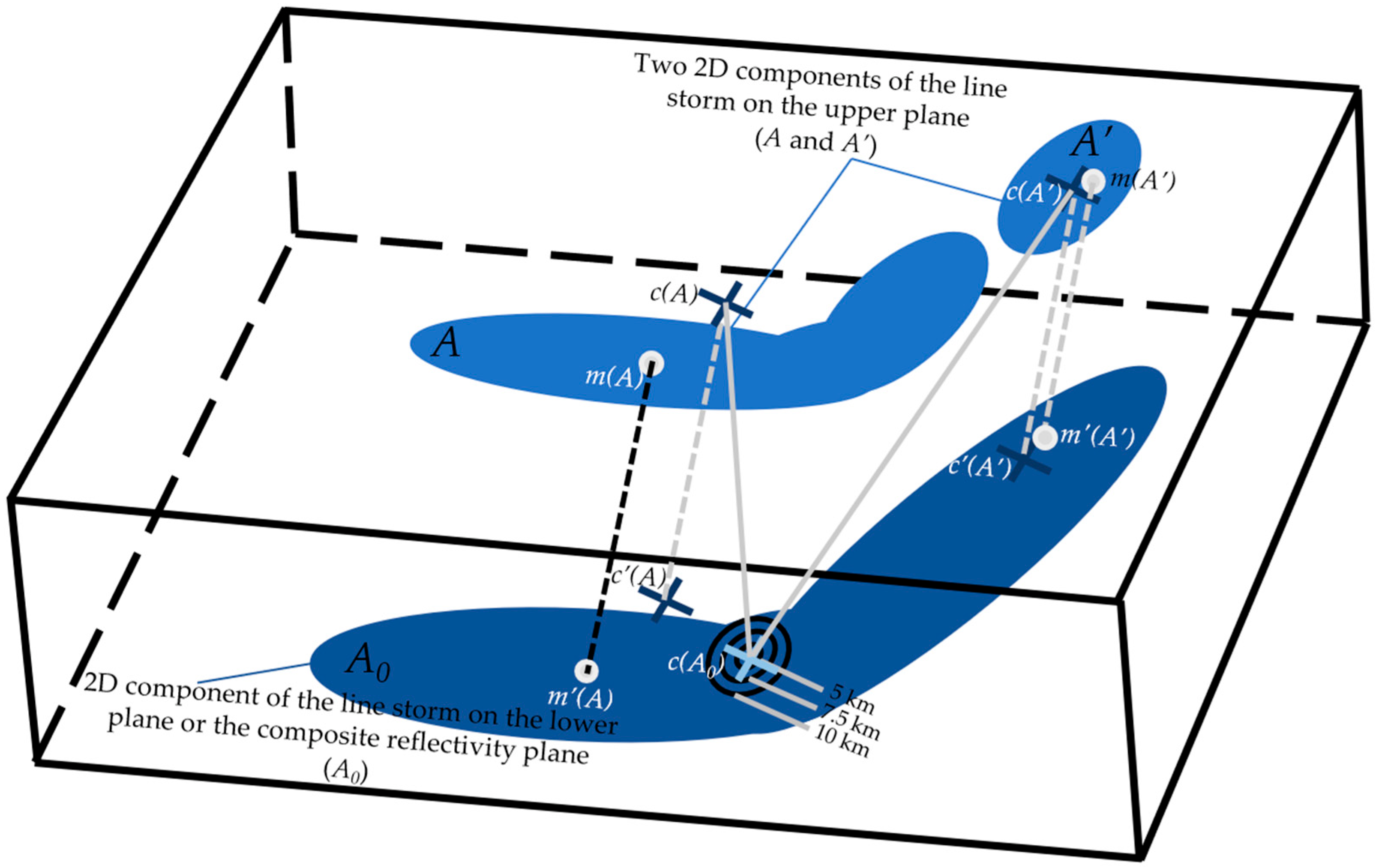
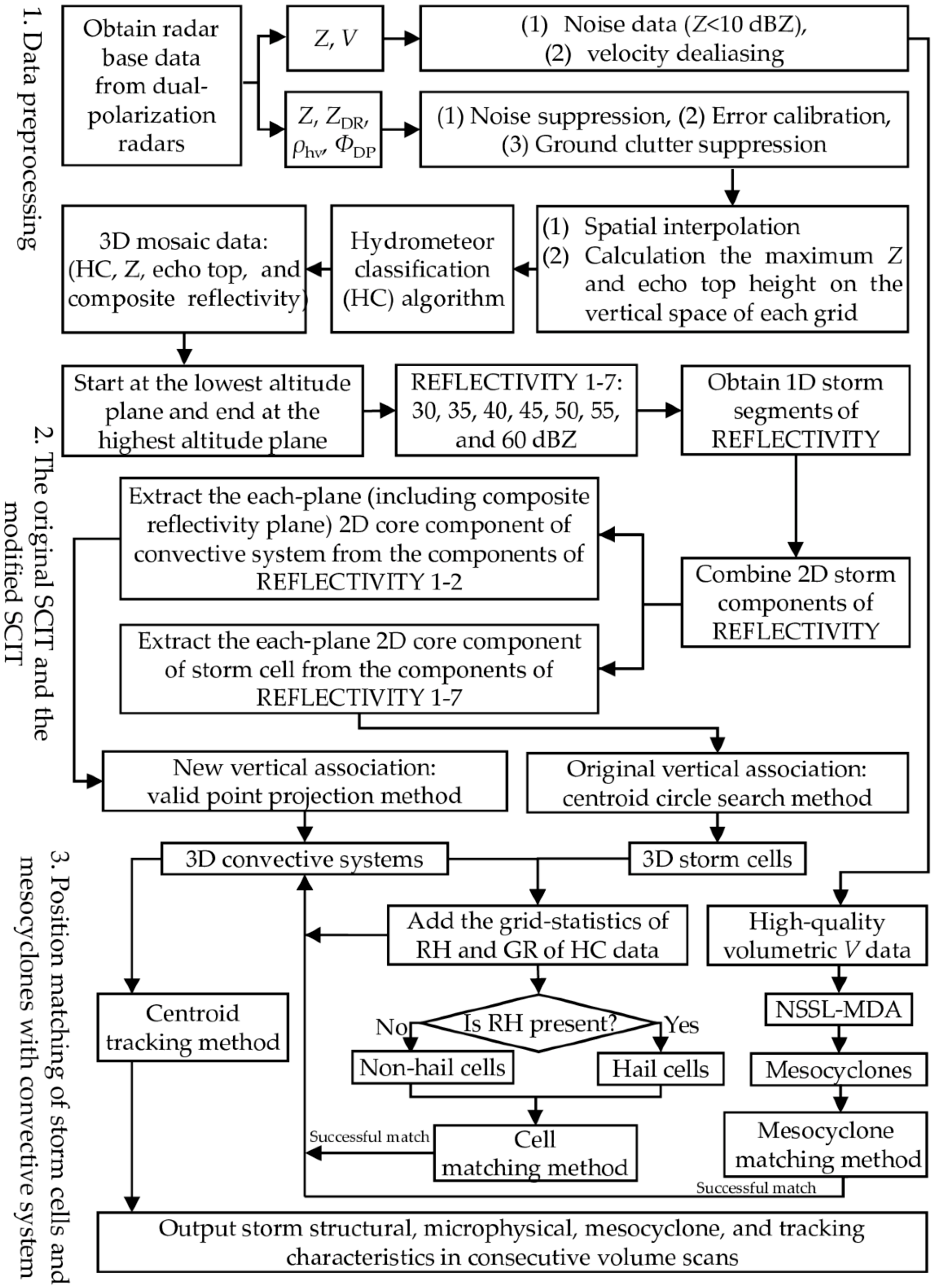
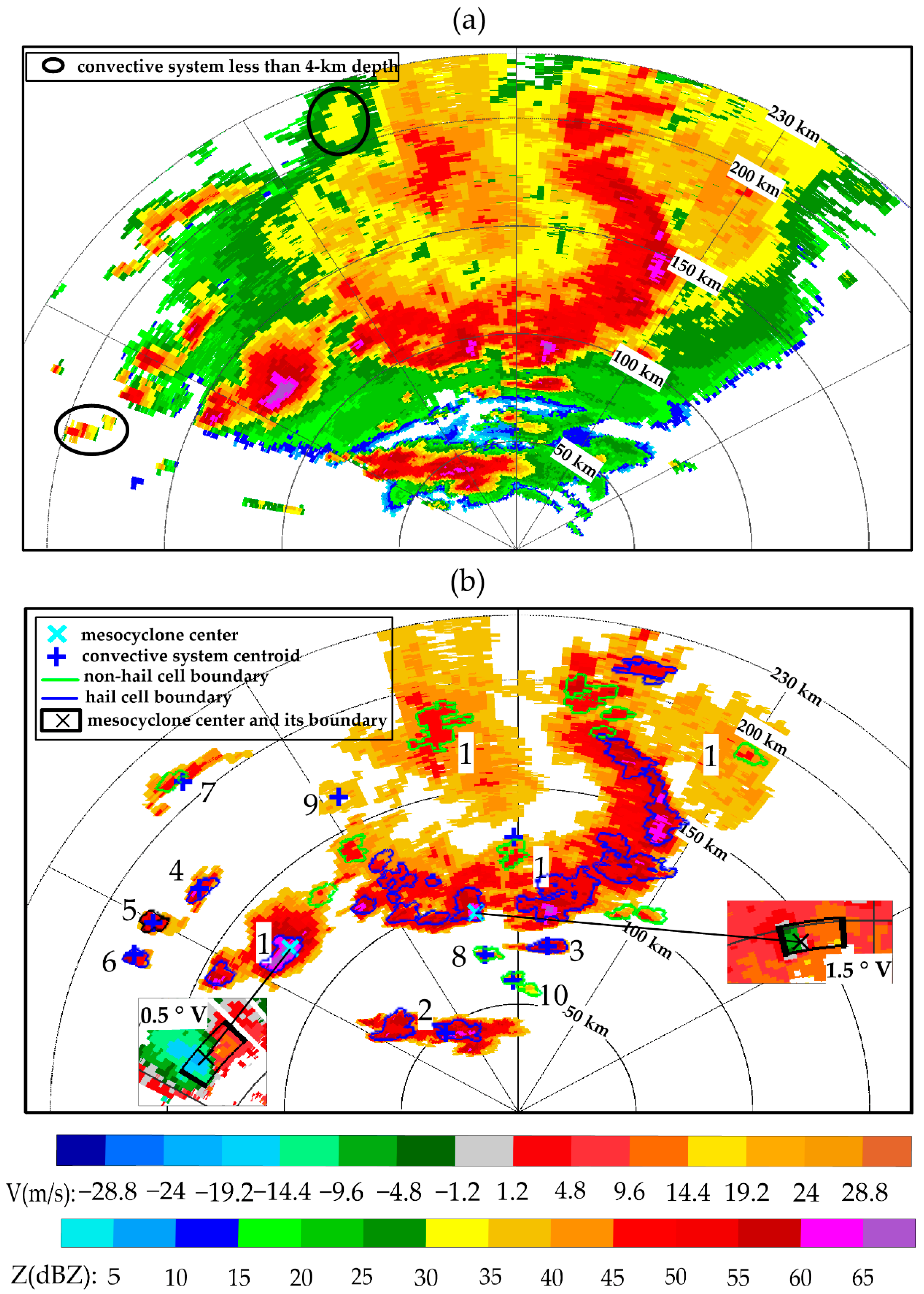

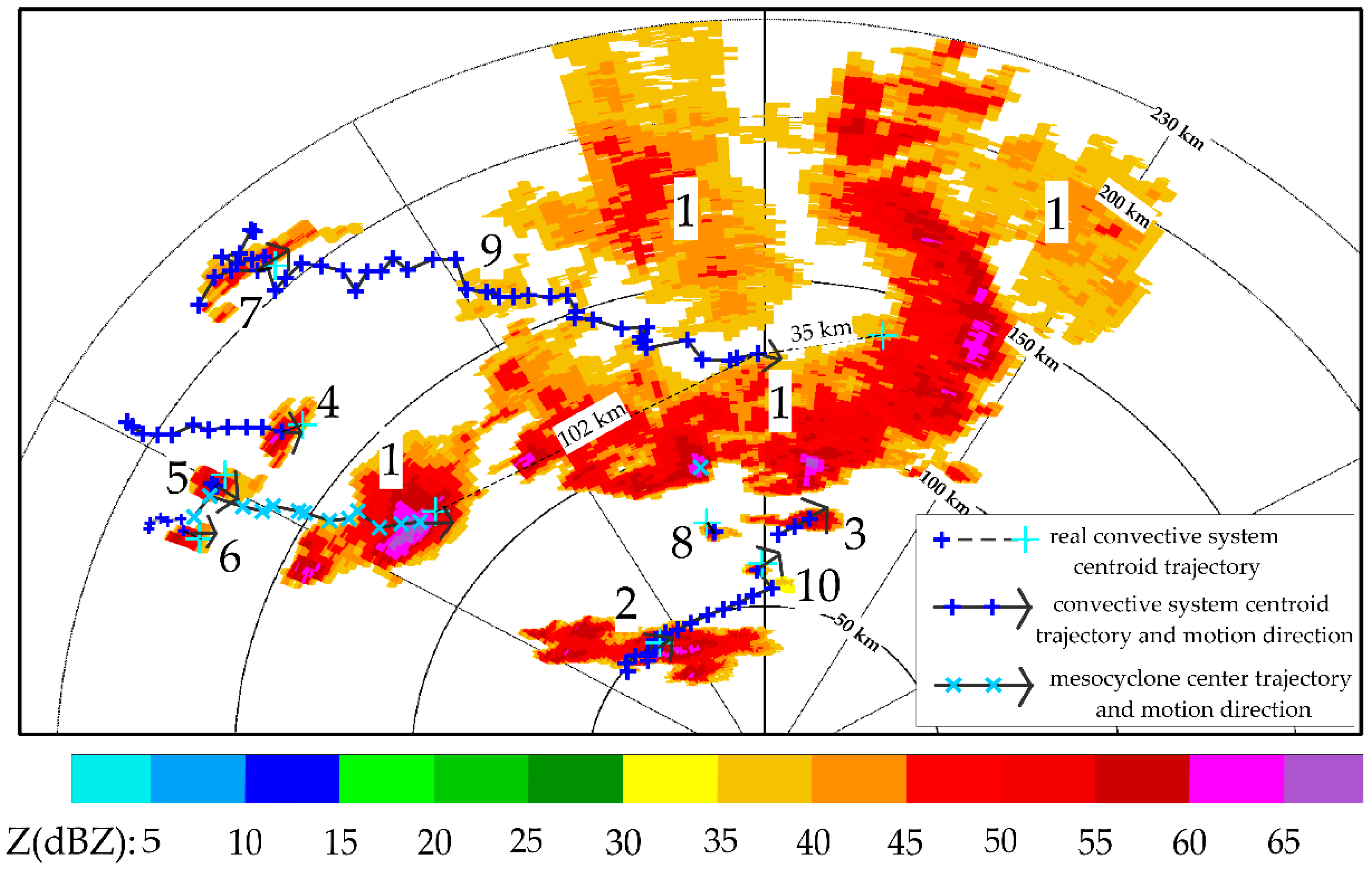

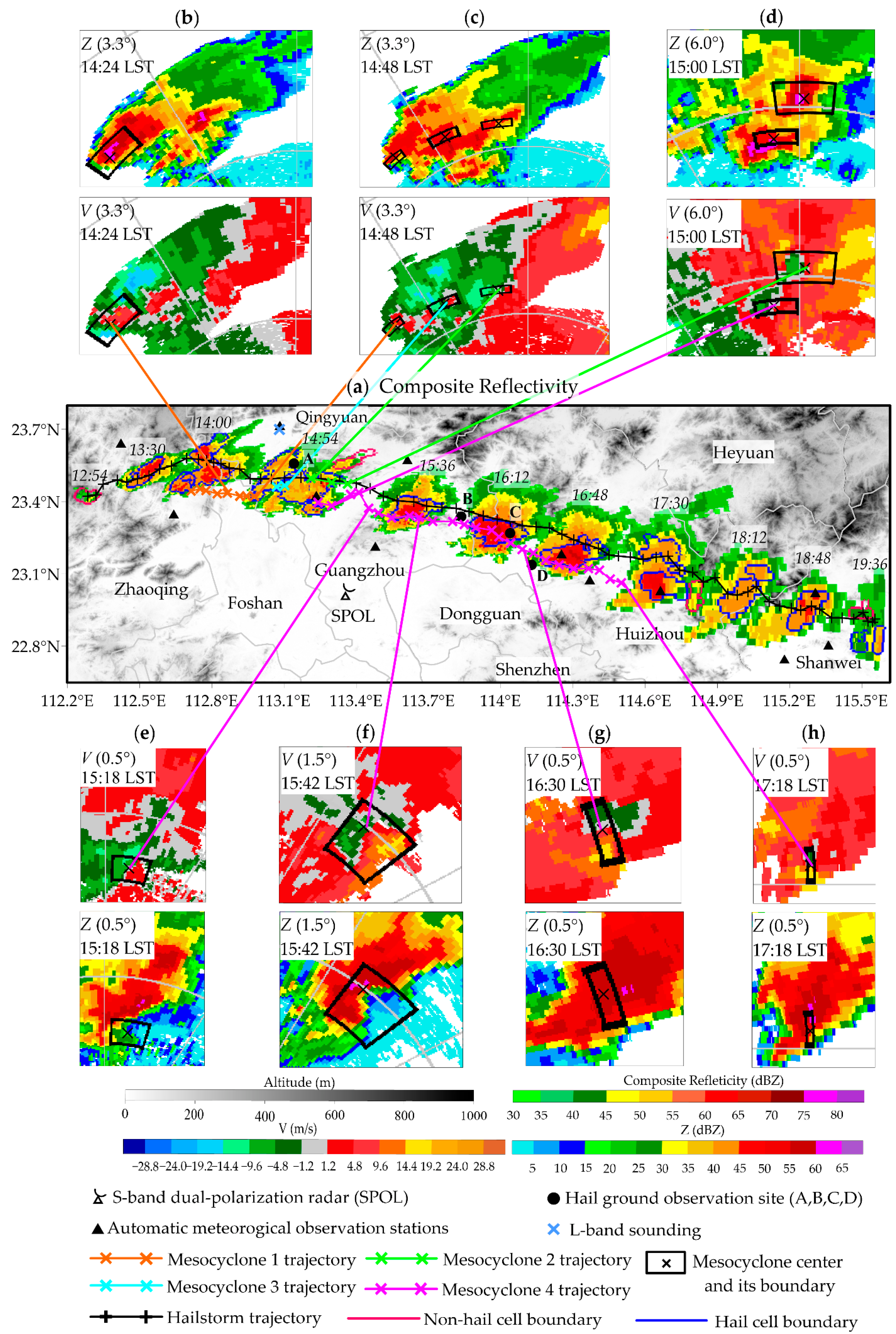

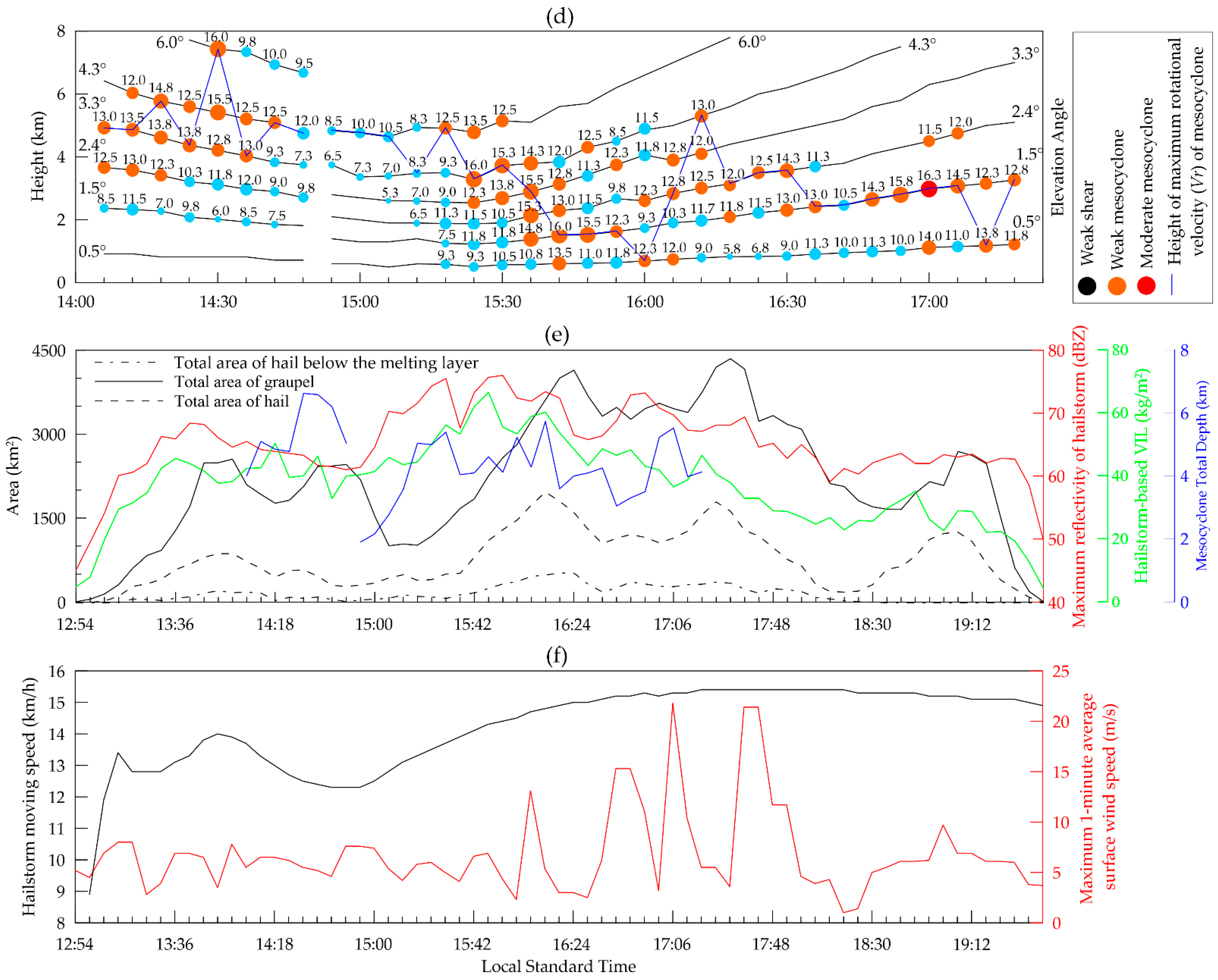
| Parameter Type | Setting |
|---|---|
| Antenna diameter (m) | 8.54 |
| Antenna gain (dB) | 45.31 |
| Beam width (°) | 1 |
| First side lobe (dB) | <−30 |
| Wavelength (cm) | 10.3 |
| Operating mode | Simultaneous horizontal and vertical transmission and reception |
| Minimum detectable power (dBm) | −117.8 |
| Volume scan mode | VCP21 (9 tilts) |
| Range resolution (km) | 0.25 |
| Measurement accuracy | Z (≤1), V (≤1), W (≤1), ρHV (≤0.01), ZDR (≤0.2), ΦDP (≤3), KDP (≤0.2) |
| # | Data (LST) | Radar City | Number of Volume Scans | Number of Mesocyclone Reports |
|---|---|---|---|---|
| 1 | 11 April 2019 | Guangzhou | 70 | 39 |
| 2 | 18 April 2019 | Guangzhou | 55 | 62 |
| 3 | 26 April 2019 | Guangzhou | 72 | 145 |
| 4 | 8 May 2021 | Meizhou | 56 | 61 |
| # | Hail Record Time (LST) | Hail Record City | Melting Layer Height (km) | −20 °C Environment Temperature Height (km) |
|---|---|---|---|---|
| A | 15:08 | Qingyuan | 3.9 | 6.9 |
| B | 16:02 | Guangzhou | 3.9 | 6.9 |
| C | 16:00–16:30 | Huizhou | 3.9 | 6.9 |
| D | 16:00–16:30 | Huizhou | 3.9 | 6.9 |
| Convective Feature Type | Parameter | Unit |
|---|---|---|
| Convective system structural characteristics | Centroid position | # |
| Height of center of mass | km | |
| Convective system top | km | |
| Convective system base | km | |
| Height of maximum reflectivity | km | |
| Maximum reflectivity | dBZ | |
| Convective-system-based VIL | kg/m2 | |
| Maximum reflectivity on each plane * | dBZ | |
| Convective system microphysical characteristics | Maximum area of hail (or graupel) | km2 |
| Height of maximum hail (or graupel) area | km | |
| Hail (or graupel) top | km | |
| Hail (or graupel) base | km | |
| Total area of hail (or graupel) | km2 | |
| Total area of hail below the melting layer | km2 | |
| Hail (or graupel) area on each plane * | km2 | |
| Storm cell (including non-hail cell and hail cell) microphysical and structural characteristics (within a convective system) | Hail cell number | 1 |
| Hail top (in the hail cell) | km | |
| Hail base (in the hail cell) | km | |
| Centroid position | # | |
| Storm cell top | km | |
| Storm cell base | km | |
| Storm-cell-based VIL | kg/m2 | |
| Maximum reflectivity of the storm cell | dBZ | |
| Height of maximum reflectivity of the storm cell | km | |
| Convective system mesocyclone characteristics | Mesocyclone number | 1 |
| Center position | # | |
| Mesocyclone total depth | km | |
| Mesocyclone top | km | |
| Mesocyclone base | km | |
| Rotational velocity on each shear layer * | m/s | |
| Maximum rotational velocity | m/s | |
| Height of maximum rotational velocity | km | |
| Shear on each shear layer * | 1/h | |
| Maximum shear | 1/h | |
| Height of maximum shear | km | |
| Diameter on each shear layer * | km | |
| Maximum diameter | km | |
| Height of maximum diameter | km | |
| Height of each shear layer * | km | |
| Convective system tracking characteristics | Convective system ID | 1 |
| Current convective system speed | km/h | |
| Current convective system direction | deg | |
| Forecast position | # |
Disclaimer/Publisher’s Note: The statements, opinions and data contained in all publications are solely those of the individual author(s) and contributor(s) and not of MDPI and/or the editor(s). MDPI and/or the editor(s) disclaim responsibility for any injury to people or property resulting from any ideas, methods, instructions or products referred to in the content. |
© 2023 by the authors. Licensee MDPI, Basel, Switzerland. This article is an open access article distributed under the terms and conditions of the Creative Commons Attribution (CC BY) license (https://creativecommons.org/licenses/by/4.0/).
Share and Cite
Wang, C.; Wu, C.; Liu, L. Integrated Convective Characteristic Extraction Algorithm for Dual Polarization Radar: Description and Application to a Convective System. Remote Sens. 2023, 15, 808. https://doi.org/10.3390/rs15030808
Wang C, Wu C, Liu L. Integrated Convective Characteristic Extraction Algorithm for Dual Polarization Radar: Description and Application to a Convective System. Remote Sensing. 2023; 15(3):808. https://doi.org/10.3390/rs15030808
Chicago/Turabian StyleWang, Chao, Chong Wu, and Liping Liu. 2023. "Integrated Convective Characteristic Extraction Algorithm for Dual Polarization Radar: Description and Application to a Convective System" Remote Sensing 15, no. 3: 808. https://doi.org/10.3390/rs15030808
APA StyleWang, C., Wu, C., & Liu, L. (2023). Integrated Convective Characteristic Extraction Algorithm for Dual Polarization Radar: Description and Application to a Convective System. Remote Sensing, 15(3), 808. https://doi.org/10.3390/rs15030808





